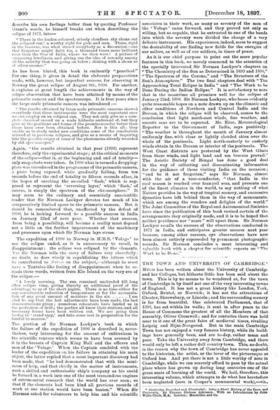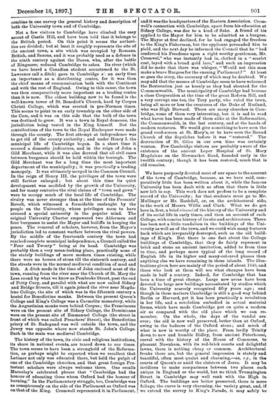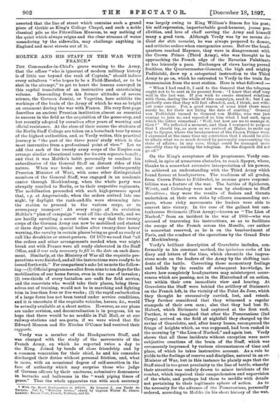THE TOWN AND UNIVERSITY OF CAMBRIDGE!'
Muer{ has been written about the University of Cambridge and her Colleges, but hitherto little has been said about the town. This is by no means to be wondered at, for the town of Cambridge is by itself not one of the very interesting towns of England. It has not a great history like London, York, Oxford, Bristol, or Norwich; it has not the attractions of Chester, Shrewsbury, or Lincoln ; and the surrounding scenery is far from beautiful. One celebrated Parliament, that of 1388, has sat within its walls ; it sent in after years to the House of Commons the greatest of all the Members of that assembly, Oliver Cromwell ; and for centuries there was held near to it one of the great fairs of mediwval times, rivalling Leipzig and Nijni-Novgorod. But in the main Cambridge Town has not enjoyed a very famous history, while its build- ings have generally been, and are to-day, rather mean and poor. Take the University away from Cambridge, and there would only be left a rather dull country town. This, no doubt, is the reason why the town of Cambridge has never appealed to the historian, the artist, or the lover of the picturesque as Oxford has. And yet there is not a little worthy of note in Cambridge, while we can scarcely afford to pass by the actual place where has grown up during long centuries one of the great seats of learning of the world. We hail, therefore, this interesting volume, which attempts to do what has heretofore been neglected (save in Cooper's monumental work),—viz., • Cambridge Described and Illustrate : being a Short History of the Town and University. By Thomas Dinham Atkinson. With an Introduction by John Willis Clark. M.A. London: Macmillan and Co.
combine in one survey the general history and description of both the University town and of Cambridge.
Not a few visitors to Cambridge have climbed the easy ascent of Castle Hill, and have been told that it belongs to the British period. On this point it seems the authori- ties are divided ; but at least it roughly represents the site of the ancient town, a site which was occupied by Romans, British, and Saxons, and it was probably used as a defence in the ninth century against the Danes, who, after the battle of Ringmere, reduced Cambridge to ashes. Its river (which we have heard a Canadian student accustomed to the St. Lawrence call a ditch) gave to Cambridge a •, an early time an importance as a distributing centre, for it was then the chief means of communication both with the Continent and with the rest of England. Owing to this cause, the town was then comparatively more important as a trading centre than it is now. The oldest building now to be found is the well-known tower of St. Benedict's Church, hard by Corpus Christi College, which was erected in pre-Norman times. This seems to point to an early township on the other side of the Cam, and it was on this side that the bulk of the town was destined to grow. It was a town in Royal demesne, the jurisdiction being vested in the King himself. But the contributions of the town to the Royal Exchequer were made through the county. The first attempt at independence was to get rid of the county authority ; and under Henry I. the municipal life of Cambridge began. In a short time it secured a domestic judicature, and in the reign of John a Gild Merchant, while it was also decreed that all civil cases between burgesses should be held within the borough. The Gild Merchant was for a long time the most important department of the municipality ; it was practically a trading monopoly. It was ultimately merged in the Common Council. In the reign of Henry III. the privileges of the town were still farther enlarged ; but about this time its quiet development was modified by the growth of the University, and for many centuries the rival claims of " town and gown" were to occupy much of the local life of Cambridge. The rivalry was never stronger than at the time of the Peasants' Revolt, which witnessed a formidable onslaught by the people on the University, whose privileges seem to have aroused a special animosity in the popular mind. The original University Charter empowered two Aldermen and four burgesses to assist the Mayor and bailiffs in keeping the peace. The removal of scholars, however, from the Mayor's jurisdiction led to constant warfare between the rival powers. By the middle of the fourteenth century the town had reached complete municipal independence, a Council called the "Four and Twenty" being at its head. Cambridge was probably then a very mean-looking place, practically none of the stately buildings of more modern times existing, while there were no houses of stone till the sixteenth century, and the streets were in the normal medimval condition of mud and filth. A ditch made in the time of John enclosed most of the town, running from the river near the Church of St. Mary the Less round by what we know as Pembroke Street, peat the end of Petty Cary, and parallel with what are now called Sidney and Bridge Streets, till it again joined the river near Magda- lene College, the site of which was in the fifteenth century a hostel for Benedictine monks. Between the present Queen's College and King's College was a Carmelite monastery, while the Augustinian monks were behind Corpus ; the Franciscans were on the present site of Sidney College, the Dominicans were on the present site of Emmanuel College (the street in front of which was called Preachers' Street), the Benedictine priory of St. Radegund was well outside the town, and the Jewry was opposite where now stands St. John's College. Such in the main was mediseval Cambridge.
The history of the town, its civic and religious institutions, its share in national events, are traced down to our times. The town seems to have been a stronghold of the Reforma- tion, as perhaps might be expected when we recollect that Latimer not only was educated there, but held the pulpit of one of the Cambridge churches, and that great foreign Pro- testant scholars were always welcome there. One recalls Macaulay's celebrated phrase that "Cambridge had the honour of educating those whom Oxford had the honour of burning." In the Parliamentary struggle, too, Cambridge was as conspicuously on the side of the Parliament as Oxford was on that of the King. Cromwell represented it in Parliament,
and it was the headquarters of the Eastern Association. Crom- well's connection with Cambridge, apart from his education at Sidney College, was due to a kind of fluke. A friend of his applied to the Mayor for him to be admitted as a burgess. The Mayor at first declined, for he had engaged the freedom to the King's Fisherman, but the applicant persuaded him to yield, and the next day he informed the Council that he "had conferred his Freedome upon a right worthy gentleman, Mr. Cromwel," who was instantly had in, clothed in a "scarlet coat, layed with a broad gold lace," and such an impression did he make that there was whisper, "Would not this man make a brave Burgess for the ensuing Parliament P " At least so goes the story, the accuracy of which may be doubted. We may add that the masses of Cambridge seem to have welcomed the Restoration just as keenly as they had shouted for the Commonwealth. The municipality of Cambridge had become a close Corporation at the time of the great Reform Bill, and a very corrupt one too, the Tory party, who ruled the town, being all more or less the creatures of the Duke of Rutland, who was High Steward. There are many churches in Cam- bridge, some of them very interesting, but it is sad to read what havoc has been made of them alike at the Reformation, the Commonwealth, in the last century, and at the hands of modern restorers. We would give something to have seen the grand rood-screen at St. Mary's, or to have seen the Round Church of the Sepulchre before it was "restored." The destruction of St. Giles in our own time was certainly wanton. Few Cambridge visitors are probably aware of the existence of the ancient Leper Hospital of St. Mary Magdalene on the Newmarket Road, founded early in the twelfth century; though it has been restored, mach that ia old remains.
We have purposely devoted most of our apace to the account of the town of Cambridge, because, as we have said, com- paratively little has been written about it, while the famous University has been dealt with so often that there is little now left to say. This work does not profess to be a complete record of the University ; for that students must go to Mr. Mullinger or Mr. Raahdall, or, on the architectural side, to the work of Messrs. Willis and Clark. What we do get here is, first, a brief re:sumg of the history of the University and of its social life in early times, and then an account of each College, with concise history of its site and architecture. There has been not a little vandalism in the buildings of the Uni- versity as well as of the town, and we could wish many features back which are irreparably destroyed, such as the old build- ings of King's. But there is one fact about the College buildings of Cambridge, that they do fairly represent in brick and stone an ancient institution, added to from time to time, and perhaps more typical of the long record of English life in its higher and many-coloured phases than anything else we have remaining in these islands. The illus- trations given here are mainly of the period of about 1840, and those who look at them will see what changes have been made in half a century. Indeed, for Cambridge that has been a time of great change. Large new areas have been devoted to large new buildings necessitated by studies which the University scarcely recognised fifty years ago ; and though in these matters Cambridge is still a good way behind Berlin or Harvard, yet it has been practically a revolution in her life, and a revolution embodied in actual material forms, which have made Cambridge put on quite a modern air as compared with the old place which we can re. member. On the whole, the days of the vandal are over; the old is now well preserved, better than at Oxford, owing to the badness of the Oxford stone ; and much of what is new is worthy of the place. From lordly Trinity down to new and humble Ridley, from ancient Peterhouse, coeval with the history of the House of Commons, to pleasant Newnham, with its red-brick courts and delightful lawns, there is nothing cheap or common. Architectural freaks there are, but the general impression is stately and beautiful, often most quaint and charming,—aa, e.g, in the courts of Queen's or amid the cloisters of Jeans. It may be invidious to make comparisons between two places each unique in England or the world, but we think Trumpington Street in Cambridge may well rank with the High in Oxford. The buildings are better preserved, there is more foliage, the curve is very charming, the variety great, and, if we extend the survey to King's Parade, it may safely be
asserted that the line of street which contains such a grand piece of Gothic as King's College Chapel, and such a noble classical pile as the Fitzwilliam Museum, to say nothing of the quiet which always reigns and the clear streams of water meandering by the sidewalks, may challenge anything in England and most streets out of it.








































 Previous page
Previous page